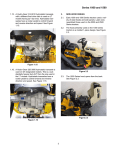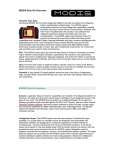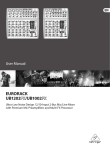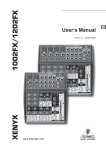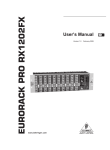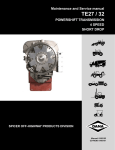Download Chrysler 2003.book(C1025.fm)
Transcript
Chrysler and Jeep Reference C1025 Subject: Transmission changes for 1989-97 FWD vehicles with A604 (41TE and 41AE) 4-speed electronic transaxles Source: Chrysler training manuals This revision outlines changes and improvements made to the A604 (41TE) front-wheel-drive (FWD) 4-speed transmissions from 1989 through 1997. 1989 Model Year Reaction Shaft Support Early 1989 transaxles had reaction shaft supports with three sealing rings. The 3-ring support was changed to a 4-ring support as a running change in February 1989. The 3-ring configuration could cause clutch failures due to internal leakage between the underdrive and overdrive circuits. The additional ring allowed the third and fourth seal rings each to perform a single sealing function and provided dual venting to the sump. Input Clutch Hub The input clutch hub bore was deepened to accommodate a new reaction shaft support length in February 1989. The revised input clutch hub (4531637) must be used with the revised (4-ring) reaction shaft support. The input clutch retainer was machined flat to allow more travel of the overdrive-reverse piston (Figure C1025-1). The change occurred in February 1989. Figure C1025-1 During 1989, the O-ring compression, or crush, was increased by making the hub O-ring groove shallower to increase the sealing between the O-rings and the input clutch retainer. The original black O-rings were replaced by orange and green Teflon-coated, tear-resistant O-rings. Some remanufactured transaxles received light blue and yellow O-rings that had a 0.007 inch larger cross section than the original. The change increased O-ring compression while still using the original hub. C69 C1025 Chrysler and Jeep Reference Transaxle Lip Seals Some overdrive-reverse piston and input clutch hub outer lip seals were out of specification (Figure C1025-2). Some 1989 and 1990 A604 Ultradrive transaxles may slip during 2-3 upshifts because of these seals. These seals can be found in other transaxle locations that are within specifications. The seals were only dropped from overdrive-reverse piston and input clutch hub outer lip seal applications. The seals can be identified by the marking “IPC.” Figure C1025-2 Parking Sprag Guide Bracket and Pawl The parking sprag bracket and pawl were changed in May 1989 from a stamped steel unit to a precision cast unit (Figure C1025-3). The cast guide bracket reduced the effort required to move the shift lever out of the park position. Figure C1025-3 C70 C1025 Chrysler and Jeep Reference Input Clutch Hub O-rings In July 1989, the input clutch hub O-rings were changed from a 0.070" to a 0.103" cross section, and the groove on the hub was deepened. This change was made to eliminate the possibility of O-ring damage during installation. The latest O-rings are red and blue. Low-Reverse Snapring Orientation When installing the low-reverse reaction plate tapered snapring, be sure to follow the removal or installation guidelines in the service manual for model years 1989 to the present (Figure C1025-4). The ends of the snapring should be opposite the oil pan face and, when installed, should be located under the case metal, not by the reaction plate lugs. Figure C1025-4 Cooler Bypass Valve An external cooler bypass valve was introduced in December 1989 to prevent potential transaxle damage due to a lack of lubrication. Under very cold conditions, the transaxle fluid may get cold enough to resist flow through the oil cooler and deprive the transaxle of lubrication (Figure C1025-5). The valve was made an integral part of the transmission. C71 C1025 Chrysler and Jeep Reference Figure C1025-5 1990 Model Year Overdrive-Reverse Piston In July 1989, for 1990 production, the 8-slot OD-reverse piston and pressure plate were upgraded to a 4-slot piston and pressure plate (Figure C1025-6). Figure C1025-6 The OD-reverse piston orifice production procedure was revised in December 1989 for 1990. The staking process and the length of the orifice assembly were changed to prevent reverse and overdrive clutch failures due to orifice blowout or incorrect orifice installation (Figure C1025-7). C72 C1025 Chrysler and Jeep Reference Figure C1025-7 Low-Reverse Piston Retainer Transaxles that experienced a “stop bump” (harsh initial or coastdown engagement) condition may have been the result of a high surface finish on the low-reverse clutch piston retainer. This was discovered in February 1990. The out-of-specification surface finish of the retainer could cause the low-reverse lip seal to wear and not energize until the TCM recognized that the shift was not completed in the specified time (Figure C1025-8). The TCM would then turn the solenoid controlling the low-reverse clutch circuit, to a fully on condition. This would apply full line pressure to the clutch, and the result was the “stop bump” condition. Figure C1025-8 C73 C1025 Chrysler and Jeep Reference Transaxle Snaprings In March 1990, the tapered snapring on the input clutch hub was modified for installation purposes. The tab on the left side of the snapring was thickened to make sure that the snapring was installed with the taper up (Figure C1025-9). Figure C1025-9 Torque Converter An additional improvement was made to the 10-inch torque converter by bonding friction material to front cover for the 3.3L and 3.8L engines. This application was upgraded from a 9.5-inch converter to handle the increased torque load of the larger engines and was introduced in June 1990. The part number is 4736076. Input Clutch Assembly In 1989 (for the 1990 model year), the input clutch and retainer were improved for durability and quality. The overdrive clutch changed from a 3-disc, 2-separator-plate assembly to a 4-disc, 3-separator-plate assembly (Figure C1025-10). Figure C1025-10 C74 C1025 Chrysler and Jeep Reference PRNDL Switch The internal contacts of the PRNDL switch were improved in January 1990. Input Clutch Hub Bushing The surface finish of the reaction shaft support journal could cause excessive wear of the input clutch hub housing. The reaction shaft and the input clutch hub machining process was revised in August 1990 to reduce wear. Overdrive-Reverse Piston The OD-reverse piston had material removed between the pressure plate snaprings. The material was not needed, and the change reduced the weight of the OD-reverse piston and allowed easier snapring installation. This change occurred during 1990 production. Underdrive-Overdrive-Reaction Plate The underdrive-overdrive reaction plate was revised as a running change in December 1990. The new plate is different in appearance from previous plates. The new plate is fully compatible with all other parts in the input clutch assembly. However, the plate must be used with a matched snapring. A mismatch of these parts can cause the plate to move, resulting in a 2-3 upshift shudder or a harsh 4-3 downshift. Low-Reverse Clutch When measuring to change low-reverse clutch pack clearance, a reduction in clearance (0.035 inch) can improve 2-1 shift quality. Piston Lip Seal For 1990 and later, the underdrive clutch piston large outer lip seal is shallower. This lip seal cannot be used with previous 1989 input clutch retainers. 1991 Model Year Torque Converter A damper assembly was added to the torque converter for the 1991 model year Cooler Bypass Valve An internal cooler bypass valve was introduced in July 1990 for the 1991 model year. It replaced the external cooler bypass valve introduced in December 1989. The cooler bypass is located in a bore in the pump face of the case. This can be recognized by a bump in the case around the pump area near the cooler fittings. Always replace the bypass valve (part number 4539880) during a transaxle overhaul. C75 C1025 Chrysler and Jeep Reference Transfer Shaft Some early transfer shafts showed signs of torsional deflection under load in lab tests. There were no field failures. A thicker transfer shaft was used to correct this condition and prevent any possible pinion or ring gear failures (Figure C1025-11). The change occurred in July 1990 for the 1991 model year. Figure C1025-11 Transaxle Case The case was modified for the 3.3L all-wheel-drive (AWD) minivan in July 1990 for the 1991 model year. The extension housing was removed, and the case was machined flat for the adapter plate installation. The adapter plate connects the transaxle to the power transfer unit. The outer differential carrier bearing was enlarged to handle the increased load. Input Shaft The input shaft was changed from a 24-tooth spline to a 22-tooth spline. The change in the number of shaft splines was made to accommodate a newly designed torque converter and prevent incorrect assembly of the two components. The new torque converter also has a damper assembly. The change covers the 1991-to-current models years. Input Clutch Retainer The input clutch retainer was changed to increase the depth of the reverse pressure plate snapring groove by 0.5mm from 143.6mm diameter. There was no part number change. The change occurred in early 1990 for the 1991 model year and was made to increase snapring retention and to ensure proper installation during production. Underdrive-Overdrive Reaction Plate An induction hardening process was introduced for the underdrive-overdrive reaction plate for the 1991 model year. The increased hardness improves plate and underdrive-overdrive tapered snapring durability. The hardening process may cause the plate to have black or dark lugs and a black or dark ring around the outer diameter of the part (Figure C1025-12). This is C76 C1025 Chrysler and Jeep Reference a normal appearance and is not to be confused with a damaged or burned plate. There are no dimensional changes to the plate. The four select part numbers were not changed. Figure C1025-12 Transaxle Friction Discs Improved friction discs are available for the overdrive and 2-4 clutches on the AWD 41AE production units and all clutches except the low-reverse for service units. The new friction material was introduced as a running change during the 1991 model year. Transfer Gears New transfer gears were introduced as a running change in May 1991. The output and transfer gear teeth have a new helix angle of 32 degrees to minimize gear whine. The previous production output and transfer gear teeth were at a 27.5-degree helix angle. The recessed area on the output transfer gear was eliminated to increase gear durability for 1991. The rear carrier output shaft is approximately 1/8-inch longer to accommodate the revised output gear. The output gear bolt and transfer shaft nut now have a Loctite material on the threads. The bolt and nut must be replaced whenever they are removed. PRNDL Switch If a vehicle built before May 1991 exhibits lighting of the backup lamps, clutch drag, slowing of the vehicle, or vehicle shudder with the transaxle selector in overdrive, a faulty PRNDL switch may be the cause. Diagnose and repair any trouble codes that may be present and then follow the repair procedure for replacing the PRNDL switch. The new switch (July 1991) can be identified by the antique bronze or olive-drab appearance of the switch housing. Valve Body A new valve body was released in May 1991 that contains aluminum spool valves for reduced leakage throughout the temperature range. The earlier steel spool valves could potentially C77 C1025 Chrysler and Jeep Reference leak because of the difference in thermal expansion of steel valves in an aluminum housing. The new valve body also contains a different converter clutch control valve that provides for an electronically modulated converter clutch (EMCC). The old valve was referred to as the lockup switch valve. In August 1991, a steel regulator valve was introduced to reduce the tendency to buzz in reverse gear. A steel valve provides increased valve stability. 1992 Model Year Separator Plates In March 1992, a revised manufacturing process for the 2-4 separator plate, low-reverse separator plate and UD-OD-reverse clutch separator was introduced to improve the quality and durability of the plates and related parts. The new parts replace the old the old in service. Differential Assembly The AWD differential has a matched set of 59-tooth and 17-tooth gears for 1992 —59 teeth for the ring gear, 17 teeth for the transfer shaft. The new AWD differential has a 2.49 overall top gear ratio. Transmission Control Module (TCM) In 1992, a new TCM and valve body were introduced on 500 AY-body vehicles. The new TCM allowed for electronically modulated converter clutch (EMCC) of the torque converter in 3rd and 4th gears. The time the vehicle could be in EMCC mode had been extended for improved fuel economy during city driving. Since that time, later software updates require disabling extended EMCC operation because it will shear the transmission fluid and cause a transmission shudder. It is recommended that the controller should be flash reprogrammed with the latest software to eliminate extended EMCC operation. EMCC also is provided in 2nd gear to minimize transaxle and engine overheating conditions. Valve Body Two changes were made to the transaxle valve body (Figure C1025-13) in 1992 to prevent a reverse buzz condition. • A 1 mm notch was cut into the valve body housing in the torque converter control valve area in November 1991. • A new valve body separator plate with reduced “T” and “Y” orifice diameters was introduced in August. Valve body repairs for 1992 models required replacement of either the valve body or the valve body separator plate, depending on the build date of the transaxle. In August 1992, the regulator valve was changed back to aluminum to provide for EMCC. C78 C1025 Chrysler and Jeep Reference Figure C1025-13 Chrysler Collision Detection (CCD) Bus In 1992, vehicles began using the CCD bus system protocol. The protocol change is the method of communication across the CCD bus. The TCM for 1992 and later vehicles will not work properly if used on 1989–91 vehicles (Figure C1025-14). Service control modules with improved features are available for 1989–91 models. Figure C1025-14 C79 C1025 Chrysler and Jeep Reference 1993 Model Year Oil Pump A revised oil pump housing and a changed reaction support casting were released in July 1992 for the 1993 model year. The changes were made to extend the cavitation point of the pump to higher engine speeds. The new pump assembly (part 4567862) can be used to replace the older design. Low-Reverse Piston The low-reverse piston outer diameters were reduced by 0.04 inch to eliminate potential thermal binding in the retainer. The casting tab was moved 1 mm (0.0394 inch). The part number did not change, and the old and new parts are interchangeable. The change occurred in July 1992 for the 1993 model year. Extension Housing and Bearing Retainers The speedometer pinion bore was removed from the extension housing in July 1992 for the 1993 model year. This eliminated the speedometer pinion, vehicle speed sensor, and associated hardware. The transmission output speed sensor is used to send a vehicle speed signal directly to the TCM. All 41TE transaxles now use the extension without the speedometer bore, but the new extension cannot replace the old one on earlier transmissions. The TCM is programmable with a “pinion factor” to calculate vehicle speed. Accumulator Springs and Pistons The inner accumulator spring was changed in July 1992 for the 1993 model year. The new spring replaces the old spring with part number 4471881. The new spring is required in all 1993 model year low-reverse and 2-4 accumulators. The low-reverse accumulator is in the case, and the 2-4 is in the valve body. The springs are shot peened and chamfered to increase durability. Some applications require a new outer spring (green) and a plain inner spring for the underdrive spring only. The change improved neutral-to-drive shift quality. Part numbers are: • Overdrive clutch outer accumulator spring — part number 4659124 (green) • Overdrive clutch inner accumulator spring — part number 4567575 (plain) Park Sprag Guide Bracket The park sprag guide bracket was modified slightly for the 1993 model year to allow the bracket to be common with the 42LE guide bracket (Figure C1025-15). The guide bracket allows easier rod installation. The new guide bracket can replace the old design. Oil Pump Seal An orange ink coating was applied to the outer diameter oil pump seal in February 1993. The coating prevents seal twist during production installation. A properly installed seal is easily identified by the orange coating on one side of the seal. If the seal is twisted, black will be visible instead of orange. There was no change to pump seal dimensions. C80 C1025 Chrysler and Jeep Reference Figure C1025-15 AWD Bearing Retainer The all-wheel-drive (AWD) bearing retainer is made in two pieces since April 1993. An additional O-ring on the outside diameter of the retainer is required with the retainer for sealing purposes. The current O-ring, part no. 4486042, is carried over for this bearing retainer assembly (Figure C1025-16). The new parts replace the old, and the part numbers are as follows: • • • • Transmission retainer plate — 47773735AB Bearing Cone — 4567382 O-ring — 6500111 Overdrive Hub and Shaft A faster machining process on the overdrive shaft spline was introduced in July 1993. The new shaft can replace the old if a new front carrier also is used. Rooster Comb and Insulator The insulator tabs on the edge of the rooster comb were widened to accommodate the electronic PRNDL display. The plastic insulator was modified to allow for wider tab slots and was released in July 1993 Torque Converter The torque converter clutch was changed to a bonded clutch disc from a free-floating clutch disc to improve durability in November 1993 for the 10 inch converter and in April 1994 for the 9.5 inch converter. C81 C1025 Chrysler and Jeep Reference Figure C1025-16 Snapring A new UD/OD reaction plate tapered snapring was introduced to improve durability. A new UD/OD reaction plate (part numbers 456740, 641, 642, 643) is used to accommodate the snapring. The new 0.16 inch snapring can replace the old if a new reaction plate also is used. Differential Assembly Two new gear tooth combinations were released for 1993 FWD and AWD differentials. The matched gear set combinations are 59/17 and 60/16. The new differential assemblies can replace the old. The matched set part numbers are: • • • • FWD 59/17 — 4531990 AWD 59/17 — 4531996 FWD 60/16 — 4531993 AWD 60/16 — 4531999 A differential assembly with high intensity shot peening to improve durability also was released in 1993. It is used with 3.8L engines. To identify, look for two grooves in the side of the differential ring gear (Figure C1025-17) and one groove in the side of the pinion gear on the transfer shaft. The part number for the matched set is 4659178 with a ratio of 60:16. TCM Pinion Factor When installing a replacement TCM for 1993 and later model years, it is necessary to set the “pinion factor”. Use the scanner and select the proper axle ratio to set the “pinion factor” so that the speedometer indicates correct mph. C82 C1025 Chrysler and Jeep Reference Figure C1025-17 TCM Quick Learn The quick-learn function applies to all 1993 and later vehicles with the 41TE transaxle if flashed properly. This option is not available for earlier vehicles. Introduced in 1993, the quick-learn function customizes, or adapts, the TCM to the particular characteristics of the vehicle transaxle. Quick learn provides improved initial shift quality after transaxle or TCM service, compared to the initial programmed parameters stored in the TCM. The quick-learn function should be performed under the following conditions: • Upon installation of new TCM • After replacement or rebuilding of internal transmission parts or the torque converter Transaxle Symptom — Harsh Shifts Harsh engagement occurs with tip-in during low-speed 2-1 downshifts, low-speed harsh 2-1 kickdown shifts, harsh 3-2 and 4-3 coastdown shifts, harsh 3-4 upshifts, harsh stationary neutral-drive shifts, park-to-reverse noise (grunt) in 1993 FWD vehicles and some 1994 vehicles. Use the scanner to diagnose and repair any diagnostic trouble codes or service any engine or transaxle related problems. If no codes are present and all systems are functioning properly, replace the TCM, change the transmission fluid, set the pinion factor in the TCM, and perform a transaxle quick-learn procedure. Transaxle Gear Retaining Strap Beginning in November 1993, 41TE transaxles used with the FWD 3.8L engine or AWD minivan have a stirrup (part 4567263) and retaining strap (part 4659134) attached to the output gear with two bolts (part 6503355, Figure C1025-18). The stirrup, strap, and bolts prevent the output gear retaining bolt from turning and backing out of the rear carrier. These C83 C1025 Chrysler and Jeep Reference additional output gear retaining parts are required because of the additional thrust loads from the new, quieter 32-degree helix-angle transfer gears and the high-output 3.8L engine. Figure C1025-18 Owner’s Manual Changes The transmission gear selection and operating instructions in the owner’s manual for all vehicles with automatic transaxles or transmissions were revised in 1993 to provide more precise transmission control, to explain the advantage of engine braking on grades, and to reduce the chance of engine overheating. The revised instructions are as follows: • Park (“P”) — Supplements the parking brake by locking the transaxle. Engine can be started in this range. Never attempt to use PARK while vehicle is in motion. Apply parking brake while leaving vehicle in this range. • Reverse (“R”) — Shift into this range only when the vehicle has come to a complete stop. • Neutral (“N”) — Engine may be started in this range. Use this range for starting your vehicle if it is moving or being towed. • Overdrive (“OD”) — This range should be used for most city and highway driving. It provides smoothest upshifts and downshifts and the best fuel economy. • Drive (“3”) — This range should be used for descending hills. The shift schedules in this range provide improved engine braking and vehicle performance at the expense of fuel economy. The transaxle will not shift into overdrive when this range is selected. Under certain conditions, this eliminates frequent shifting between third gear and overdrive. • Low (“L’) — This range should be used for maximum engine braking when descending steep grades. In this range, upshifts will occur only to prevent engine overspeed while downshifts occur as early as possible. C84 C1025 Chrysler and Jeep Reference 1994 Model Year Front Carrier Assembly A new overdrive shaft for 1994 required that the front carrier hub internal spline be recessed for overdrive shaft clearance. The shaft and front carrier were changed in July 1993 for the 1994 model year. The bearing pocket in the front carrier was made larger and deeper to accommodate the common no. 2, 5, and 7 thrust bearings (Figure C1025-19). The new carrier replaces the old. Figure C1025-19 Thrust Bearings The no. 2, 5, and 7 thrust bearings became common in July 1993 for the 1994 model year, figure 19. This reduced the number of bearing assemblies required for the no. 2, 5, and 7 positions. Previously, two part numbers were used. The new thrust bearing part number is 4567262. The old part numbers were 4431962 for the no. 2 and 5 bearings, and 4412209 for the no. 7 bearing. Valve Body A new valve body and transfer plate assembly were introduced in July 1993 for the 1994 model year to eliminate valve body whistle. The regulator valve was modified to add a ground step diameter for full-time oil feed to the torque converter. The valve body steel separator plate has the X1 orifice eliminated (Figure C1025-20). Snapring The UD/OD reaction plate tapered snapring uses a new material for improved durability. The change was effective in April 1994 with no part number change. C85 C1025 Chrysler and Jeep Reference Figure C1025-20 1995 Model Year Input Clutch Hub A dirt collection groove was added under the input clutch hub lip seal groove to improve durability. The underdrive clutch feed orifice in the input clutch hub also was reduced in size to minimize the UD clutch cavity transient pressure loss. The change improved shift quality and occurred for the 1995 model year. The part number is 4531637. Overdrive-Reverse Piston For the 1995 model year, the bottom of the OD-reverse piston slots where the OD-reverse pressure plate fits was given a D-shaped cutout (Figure C1025-21) to allow better oil flow and reduce powdery debris buildup that could affect lip seal function. Overdrive-Reverse Clutch Pressure Plate The OD-reverse clutch pressure plate material was changed for 1995 to improve durability. The pressure plate can be identified by a dimple in one of the drive hubs. The part number is 5017518AB. Underdrive Clutch Hub and Shaft Assembly The underdrive hub and shaft assembly has an added step to eliminate burrs caused by the face grinding process. Added clearance for a redesigned spring pack also was provided. C86 C1025 Chrysler and Jeep Reference Figure C1025-21 2-4 Clutch Piston Retainer A lance-bleed orifice was added to the 2-4 piston retainer to improve shift quality in 1995. The new retainer part number is 5102880AA. Piston Lip Seals The underdrive clutch piston inner lip seal material was changed for 1995. The new seal replaces the old one. The low-reverse piston lip seals also were revised in 1995. The new lip seals are D-shaped rings to improve installation during production. The new seals service the old. Differential Case, Side Gears, Seal Retainer, and Extension Housing The differential side gears and the differential case for the 41TE were modified to accept circlips on the axle shafts for 1995. This improved axle shaft retention and overall quality. The inside diameters of the oil dams in the differential bearing retainer and extension housings have been increased to accommodate the axle shafts with the circlips. The change began with production for the 1995 model year. Part numbers for the oil dams are as follows: • Left oil dam — 4567493 (new), 4269787 (old) • Right oil dam — 4567494 (new), 5222255 (old) The differential bearing retainer seal for some models also was changed for 1995. The new part number is 4567496 (green) to replace 4412522 (old — blue). For servicing, the new seal, part number 4762418 (green), must be used so that the current special tool can be used without damage to the seal. C87 C1025 Chrysler and Jeep Reference Some transaxles require a short aluminum extension housing (Figure C1025-22) part number 4567337. The old extension housing part number is 4567412. Figure C1025-22 Transaxle Covers The outside contour of the differential cover was revised for added vehicle clearance in July 1993 for 1994 models. The differential gear cover was revised for 1995 in preparation for the rear mount. The wiring tab also was moved to provide additional clearance for the new Minivan. The transfer gear cover was raised to accept the stirrup and strap retainer for the output bolt (Figure C1025-23). The transfer gear cover outside contour and the gear pockets were revised to accommodate new axle shafts and new ratio transfer gears on future models. Figure C1025-23 C88 C1025 Chrysler and Jeep Reference The new covers can replace the old. The part numbers below for the differential cover are for the 1995 model year. • Differential cover — 4659520 (new), 4659093 (old) • Transfer gear cover — 4659636 (new), 4567255 (old) 1996 Model Year Transmission Range Sensor (TRS) The transmission range sensor (TRS) is located on top of the valve body. The TRS replaces both the gear position switch and the transmission range switch to provide transaxle gear position measurement. A separate transmission temperature sensor, located inside the TRS, measures transmission fluid sump temperature. The temperature sensor is serviced with the TRS as a unit. The TRS sends a signal to the TCM on the position of the transaxle manual valve lever. The TCM receives the signal and processes the data. The TCM sends the shift lever position (SLP) information to the body control module (BCM) over the CCD bus. The BCM then lights the appropriate shifter position indicator in the instrument cluster. Transaxle Case Mounting The 41TE transaxle for 1995-1/2 has a 4-point engine-to-transmission mounting system. Earlier models used a 3-point mounting. The casting change (3 bosses on top of the differential case) was made early in 1995 for 3.3L engines. This casting change also affected some past models with ABS. The 3.0L case does not get the fourth mount, and the 2.2L and 2.5L case castings have always had the fourth mount. • 3.3L and 3.8L case part numbers — 4567013 (3 mount), 4567533 (4 mount) • Case casting part numbers — 4539572 (3 mount), 4567534 (4 mount) Upgraded Differential The differential was changed to improve durability of the left side differential bearing. The changes are listed below: • Differential bearing retainer — Bearing bore increased in diameter for larger bearing. Flange thickness was also increased by 2mm. • Differential bearing retainer bolt — Longer bolt and a 360-degree patch to seal the holes tapped through the case. • Cup and cone — Larger diameter left side differential bearing cup and cone. • Oil dam — Left side bearing baffle to match the bearing cone. • Select differential bearing retainer shim — Select-fit differential bearing shims for adjusting bearing preload. • Case — Tapped for the longer differential bearing retainer holes bolts. • Differential assembly — Differential hub size change to accommodate the larger bearing. • Reduced differential backlash. C89 C1025 Chrysler and Jeep Reference Valve Body Improvements Several changes were made to the valve body for 1996 on 41TE transaxles. The major changes were the addition of two new valves: Low-reverse switch valve — This has taken the place of the no. 1 check ball to provide a more positive design and to avoid the possibility of a sticking check ball. In pre-1996 designs, the check ball tended to stick, so the new switch valve was necessary. Torque converter limit valve — The X1 orifice was eliminated, and a small undercut was machined into the limit valve to provide a constant bleed to the converter. Additionally, the torque converter control valve was modified to delete the function of regulating the flow to the torque converter when the converter clutch is not applied. The modification was made to reduce the sticking tendencies that could occur when fluid from the torque converter was routed through the valve. The valve switches the direction of fluid flow when the converter clutch is applied and vents the release side of the torque converter clutch. Overdrive Shaft A thicker overdrive shaft was added for improved strength along with a thin-wall shaft bushing and a thinner wall front sun gear bushing. When replaced together, the new overdrive shaft assembly and sun gear assembly can replace the old. Rear Carrier Changes to the cup and plate of the rear carrier allowed a stronger, 360-degree weld instead of the previous segmented weld. 1997 Model Year The reaction plates were reduced from four to three plates. The tapered snapring and flat snapring on either side of the UD/OD clutch were increased in size to 0.015 inch. Therefore, a sleeved reaction shaft support was added and the input clutch retainer was revised. The cover assembly also was modified to be a “sandwiched” cover that consists of a layer of metal, then a layer of plastic, and then metal. This change helped reduce transfer gear noise. C90






















